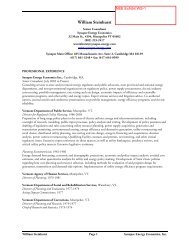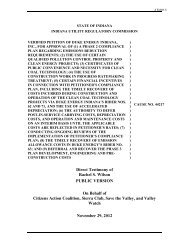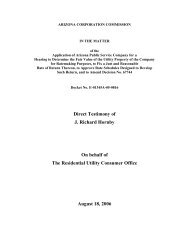Best Practices in Energy Efficiency Program Screening - Synapse ...
Best Practices in Energy Efficiency Program Screening - Synapse ...
Best Practices in Energy Efficiency Program Screening - Synapse ...
You also want an ePaper? Increase the reach of your titles
YUMPU automatically turns print PDFs into web optimized ePapers that Google loves.
Some program adm<strong>in</strong>istrators use the costs associated with a new power plant, e.g., a<br />
new peak<strong>in</strong>g combustion turb<strong>in</strong>e, to forecast avoided capacity costs. If this approach is<br />
used it is important to separate the capacity costs associated with the peak<strong>in</strong>g unit from<br />
the energy costs.<br />
3.4 Avoided Transmission and Distribution Costs<br />
Introduction<br />
The US utility sector has <strong>in</strong>vested on the order of $35 to $40 billion per year <strong>in</strong> the T&D<br />
system over the past decade and is forecast to <strong>in</strong>vest nearly $50 billion per year over the<br />
next two decades (RAP 2012). <strong>Energy</strong> efficiency has the potential to defer forecasted<br />
T&D <strong>in</strong>vestments. While not all forecast T&D <strong>in</strong>vestments will be deferrable due to timerelated<br />
deterioration of equipment or other factors, a significant portion of T&D<br />
<strong>in</strong>vestment is likely to be associated with load growth. The potential benefits of deferr<strong>in</strong>g<br />
even a modest portion of such <strong>in</strong>vestments could be substantial. Most states <strong>in</strong>clude<br />
some value for avoided T&D <strong>in</strong> their calculation of avoided costs (ACEEE 2012, p.32).<br />
There are two types of categories of avoided T&D costs, based on whether energy<br />
efficiency programs target at specific areas to alleviate congestions of specific T&D<br />
facilities. One type of avoided cost is called “passive deferral,” which occurs from typical<br />
energy efficiency programs when the growth <strong>in</strong> load or stress on of the T&D system is<br />
reduced as a result of broad-based (e.g., statewide or utility service territory-wide)<br />
efficiency programs. Another type of deferral is called “active deferral,” which occurs<br />
when a conscious decision is made to <strong>in</strong>vest <strong>in</strong> energy efficiency measures or programs<br />
<strong>in</strong> targeted geographic locations for the specific purpose of lower<strong>in</strong>g loads on local T&D<br />
system elements. (RAP 2012, pp. 3 – 4). 17<br />
T&D Avoided Cost Methodologies<br />
T&D avoided cost values can be constructed by estimat<strong>in</strong>g historical annual marg<strong>in</strong>al<br />
T&D <strong>in</strong>vestment, or by evaluat<strong>in</strong>g planned, future T&D <strong>in</strong>vestment at specific sites. One<br />
common method for estimat<strong>in</strong>g avoided T&D costs is called “projected embedded<br />
analysis.” In this method, utilities use long-term historical trends (more than 10 years)<br />
and sometimes planned T&D costs to estimate future avoided T&D costs. (NARUC<br />
1992) This approach often looks at load-related <strong>in</strong>vestment (as opposed to customerrelated)<br />
and estimates system-wide (e.g., utility service territory) average avoided T&D<br />
costs. It has been ma<strong>in</strong>ly applied to the evaluation of the benefits of energy efficiency<br />
programs (as opposed to other resources such as distributed generation and demand<br />
response).<br />
This approach is relatively <strong>in</strong>expensive and less time consum<strong>in</strong>g than the system<br />
plann<strong>in</strong>g approach as it does not require an eng<strong>in</strong>eer<strong>in</strong>g study of the electric system, nor<br />
does it require obta<strong>in</strong><strong>in</strong>g site specific load and <strong>in</strong>vestment data. As a weak po<strong>in</strong>t, it does<br />
17 In recent years, aggressive geographically targeted energy efficiency programs have been implemented<br />
<strong>in</strong> several jurisdictions <strong>in</strong> an attempt to defer specific T&D projects. Examples <strong>in</strong>clude Pacific Gas and<br />
Electric’s Delta Project, Portland General Electric’s Downtown Portland Pilot, Consolidated Edison<br />
programs, <strong>Efficiency</strong> Vermont Geo-Targeted DSM, and National Grid projects <strong>in</strong> Rhode Island (RAP<br />
2012).<br />
| 24 <strong>Best</strong> <strong>Practices</strong> <strong>in</strong> <strong>Energy</strong> <strong>Efficiency</strong> <strong>Program</strong> Screen<strong>in</strong>g | www.nhpci.org







